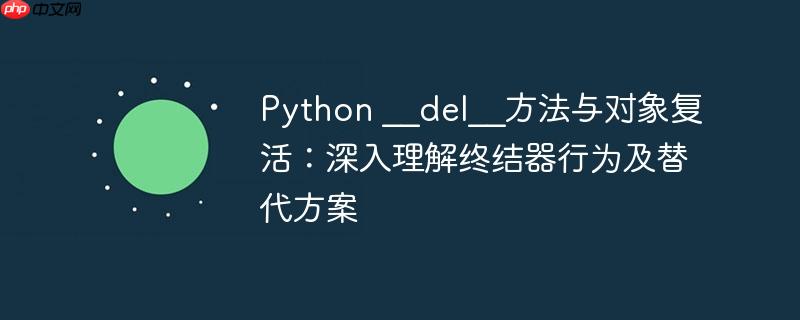
__del__方法是python中的一个特殊方法,被称为“终结器”(finalizer)。它在对象即将被垃圾回收时调用,通常用于执行清理操作,例如关闭文件句柄、释放外部资源等。当一个对象的引用计数降为零,且没有其他循环引用导致其无法被回收时,python解释器会尝试调用其__del__方法。
然而,与C++等语言的析构函数不同,__del__的调用时机是不确定的。它依赖于垃圾回收机制,而垃圾回收的时机是不可预测的。此外,__del__方法本身也存在一些复杂性,尤其是在涉及对象“复活”的情况下。
对象复活是指在__del__方法执行期间,通过某种方式重新创建一个对该对象的引用,从而阻止其被垃圾回收。这意味着对象在即将被销毁时,又“活”了过来。
考虑以下示例代码,它尝试在__del__方法中将对象存储到一个全局缓存中,从而实现对象的复活:
cache = []
class Temp:
def __init__(self) -> None:
self.cache = True
print(f"Temp object created, cache_flag: {self.cache}")
def __del__(self) -> None:
print('Running del')
if self.cache:
# 在 __del__ 中重新创建对 self 的引用,实现对象复活
cache.append(self)
print("Object resurrected and added to cache.")
def main():
temp = Temp()
print(f"Inside main, temp.cache: {temp.cache}")
# temp 离开作用域,引用计数降为0,__del__ 预期被调用
main()
print("Main function finished.")
if cache:
print(f"Cache contains resurrected object. cache[0].cache: {cache[0].cache}")
print("Program end.")当运行这段代码时,输出如下:
立即学习“Python免费学习笔记(深入)”;
Temp object created, cache_flag: True Inside main, temp.cache: True Running del Object resurrected and added to cache. Main function finished. Cache contains resurrected object. cache[0].cache: True Program end.
观察输出,Running del只被打印了一次。尽管main()函数结束后temp对象离开了作用域,其__del__被调用,并且在__del__内部通过cache.append(self)重新创建了一个引用,使得对象被复活。然而,在程序结束时,这个被复活的对象并没有再次调用其__del__方法。
这种行为并非偶然,而是CPython解释器的特定实现。根据PEP 442 (Explicit control over object finalization),Python对在__del__中被复活的对象在解释器关闭时有特殊的处理。
在旧版本的Python中,对象复活可能导致解释器崩溃。PEP 442旨在使对象复活更加健壮,但它明确指出:CPython解释器在关闭时,不会对那些在__del__方法中被复活的对象再次调用__del__。
这是因为在解释器关闭阶段,许多全局对象(包括模块、类、函数等)可能已经被部分或完全清理。此时,再次调用__del__可能会尝试访问一个已经不存在或处于不一致状态的资源,从而导致不可预测的行为甚至崩溃。为了避免这种风险,CPython选择在解释器关闭时跳过对已复活对象的二次终结。
因此,即使一个对象在__del__中被成功复活并保留了新的引用,当程序最终退出时,如果这个新的引用依然存在,CPython也不会再次触发其__del__方法。
鉴于__del__的调用时机不确定性以及复活对象的特殊处理,使用__del__进行资源管理存在诸多风险:
为了避免__del__带来的不确定性和风险,Python提供了更安全、更可靠的资源管理机制:
上下文管理器是Python中管理资源的首选方式。通过实现__enter__和__exit__方法,可以确保资源在进入和离开特定代码块时被正确地获取和释放,无论代码块中是否发生异常。
示例:
class ManagedResource:
def __init__(self, name):
self.name = name
print(f"Resource '{self.name}' initialized.")
def __enter__(self):
print(f"Resource '{self.name}' acquired.")
return self
def __exit__(self, exc_type, exc_val, exc_tb):
print(f"Resource '{self.name}' released.")
if exc_type:
print(f"An exception occurred: {exc_val}")
return False # 不抑制异常
# 使用上下文管理器
print("--- Using Context Manager ---")
with ManagedResource("FileHandler") as res:
print(f"Working with {res.name}")
# 模拟操作
print("--- Context Manager Finished ---")
# 模拟异常情况
print("\n--- Using Context Manager with Exception ---")
try:
with ManagedResource("DatabaseConnection") as db:
print(f"Connecting to {db.name}")
raise ValueError("Simulated database error")
except ValueError as e:
print(f"Caught exception outside context: {e}")
print("--- Context Manager with Exception Finished ---")输出:
--- Using Context Manager --- Resource 'FileHandler' initialized. Resource 'FileHandler' acquired. Working with FileHandler Resource 'FileHandler' released. --- Context Manager Finished --- --- Using Context Manager with Exception --- Resource 'DatabaseConnection' initialized. Resource 'DatabaseConnection' acquired. Connecting to DatabaseConnection Resource 'DatabaseConnection' released. An exception occurred: Simulated database error Caught exception outside context: Simulated database error --- Context Manager with Exception Finished ---
with语句保证了__exit__方法总会被调用,从而确保资源被及时释放,提供了确定性的清理。
atexit模块提供了一种注册函数的方法,这些函数将在解释器正常关闭时被调用。这对于需要在程序退出前执行全局清理操作(例如保存数据到数据库或清理临时文件)的场景非常有用,尤其是在上下文管理器不适用(例如,对象生命周期与特定代码块不绑定)的情况下。
示例:
import atexit
class DataSaver:
def __init__(self, data_source):
self.data = data_source
self.is_saved = False
print(f"DataSaver initialized for {self.data}")
# 注册清理函数
atexit.register(self.save_data_on_exit)
def save_data_on_exit(self):
if not self.is_saved:
print(f"Saving data '{self.data}' to persistent storage via atexit...")
# 模拟数据保存操作
self.is_saved = True
else:
print(f"Data '{self.data}' already saved.")
# 创建一个DataSaver对象
saver = DataSaver("User Preferences")
# 可以在程序运行期间进行其他操作
print("Program running...")
# 模拟程序即将退出
# 此时,atexit注册的save_data_on_exit会被调用输出:
DataSaver initialized for User Preferences Program running... Saving data 'User Preferences' to persistent storage via atexit...
atexit注册的函数会在程序正常退出时按注册的逆序执行,提供了一种可靠的全局清理机制。
__del__方法是Python对象生命周期的一部分,但其调用时机和行为(尤其是在对象复活和解释器关闭时)具有不确定性,不建议将其作为主要的资源管理工具。CPython对在__del__中被复活的对象在解释器关闭时不会再次调用__del__,这是为了避免潜在的崩溃。
对于确定性的资源管理,应优先使用上下文管理器 (with 语句)。对于需要在程序退出时执行的全局清理任务,atexit模块提供了更健壮和可预测的解决方案。理解这些机制的差异和适用场景,有助于编写更稳定、更可靠的Python代码。
以上就是Python __del__方法与对象复活:深入理解终结器行为及替代方案的详细内容,更多请关注php中文网其它相关文章!

每个人都需要一台速度更快、更稳定的 PC。随着时间的推移,垃圾文件、旧注册表数据和不必要的后台进程会占用资源并降低性能。幸运的是,许多工具可以让 Windows 保持平稳运行。

Copyright 2014-2025 https://www.php.cn/ All Rights Reserved | php.cn | 湘ICP备2023035733号